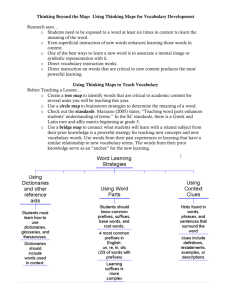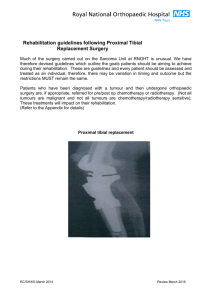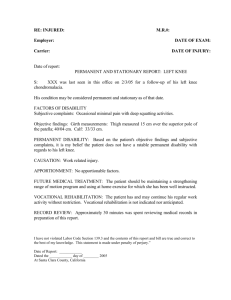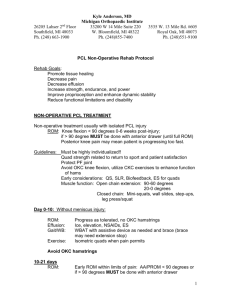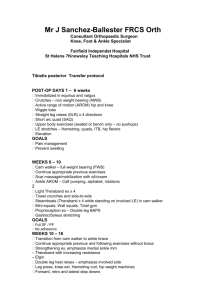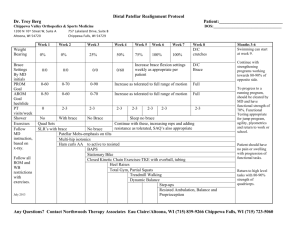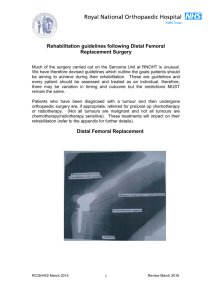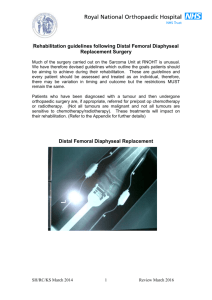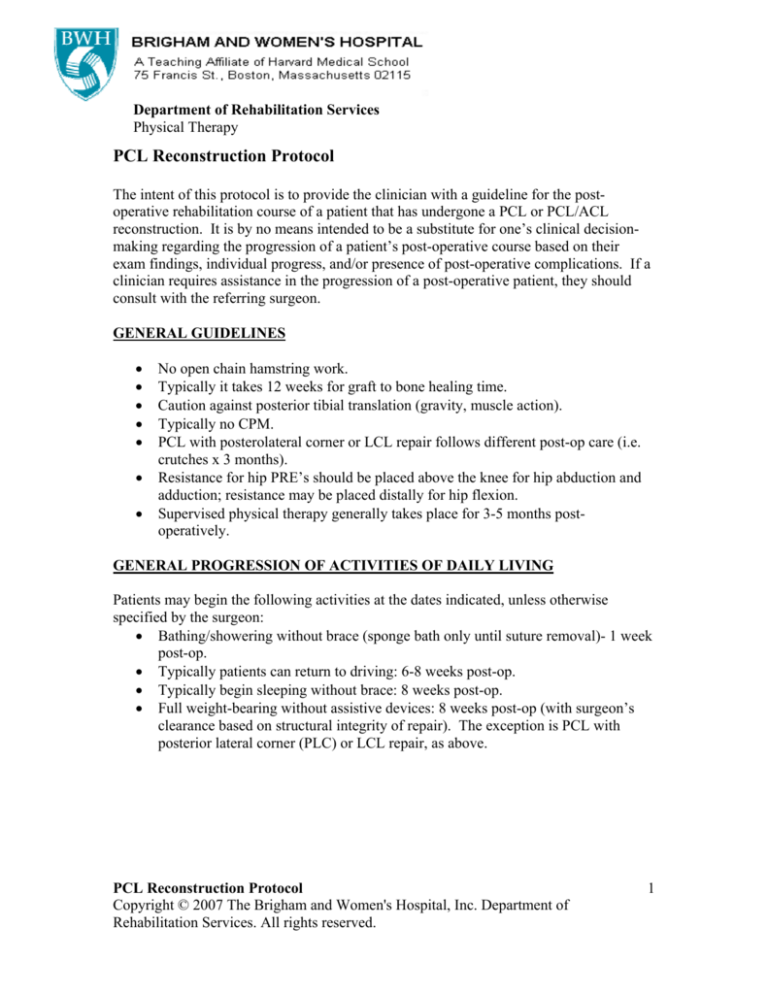
Department of Rehabilitation Services
Physical Therapy
PCL Reconstruction Protocol
The intent of this protocol is to provide the clinician with a guideline for the postoperative rehabilitation course of a patient that has undergone a PCL or PCL/ACL
reconstruction. It is by no means intended to be a substitute for one’s clinical decisionmaking regarding the progression of a patient’s post-operative course based on their
exam findings, individual progress, and/or presence of post-operative complications. If a
clinician requires assistance in the progression of a post-operative patient, they should
consult with the referring surgeon.
GENERAL GUIDELINES
•
•
•
•
•
•
•
No open chain hamstring work.
Typically it takes 12 weeks for graft to bone healing time.
Caution against posterior tibial translation (gravity, muscle action).
Typically no CPM.
PCL with posterolateral corner or LCL repair follows different post-op care (i.e.
crutches x 3 months).
Resistance for hip PRE’s should be placed above the knee for hip abduction and
adduction; resistance may be placed distally for hip flexion.
Supervised physical therapy generally takes place for 3-5 months postoperatively.
GENERAL PROGRESSION OF ACTIVITIES OF DAILY LIVING
Patients may begin the following activities at the dates indicated, unless otherwise
specified by the surgeon:
• Bathing/showering without brace (sponge bath only until suture removal)- 1 week
post-op.
• Typically patients can return to driving: 6-8 weeks post-op.
• Typically begin sleeping without brace: 8 weeks post-op.
• Full weight-bearing without assistive devices: 8 weeks post-op (with surgeon’s
clearance based on structural integrity of repair). The exception is PCL with
posterior lateral corner (PLC) or LCL repair, as above.
PCL Reconstruction Protocol
Copyright © 2007 The Brigham and Women's Hospital, Inc. Department of
Rehabilitation Services. All rights reserved.
1
REHABILITATION PROGRESSION
PHASE I: Immediately post-operatively to week 4
Goals:
• Protect healing bony and soft tissue structures.
• Minimize the effects of immobilization:
o Early protected range of motion (protect against posterior tibial sagging).
o PRE’s for quadriceps, hip, and calf with an emphasis on limiting
patellofemoral joint compression and posterior tibial translation.
• Patient education for a clear understanding of limitations and expectations of the
rehabilitation process, and need for supporting proximal tibia/preventing sag.
Brace:
• 0-1 week: post-op brace locked in full extension at all times.
• At 1 week post-op, brace is unlocked for passive ROM performed by a physical
therapist or PT assistant.
• Technique for passive ROM is as follows:
o Patient supine; therapist maintains anterior pressure on proximal tibia as
knee is flexed (force on tibia is from posterior to anterior).
o For patients with combined PCL/ACL reconstructions, the above
technique is modified such that a neutral position of the proximal tibia is
maintained as the knee is flexed.
o It is important to prevent posterior sagging at all times.
Weight-bearing status:
• Weight-bearing as tolerated (WBAT) with crutches, brace locked in extension.
Special considerations:
• Position pillow under proximal posterior tibia at rest to prevent posterior tibial
sag.
Therapeutic exercises:
• Patellar mobilization.
• Quadriceps sets.
• Straight leg raise (SLR).
• Hip abduction and adduction.
• Ankle pumps.
• Hamstring and calf stretching.
• Calf press with exercise bands, progressing to standing calf raise with full knee
extension.
• Standing hip extension from neutral.
PCL Reconstruction Protocol
Copyright © 2007 The Brigham and Women's Hospital, Inc. Department of
Rehabilitation Services. All rights reserved.
2
•
Functional electrical stimulation (as needed for trace to poor quadriceps
contraction).
PHASE II: Post-operative weeks 4 to 12
Criteria for progression to Phase II:
• Good quadriceps control (good quad set, no lag with SLR).
• Approximately 60 degrees knee flexion.
• Full knee extension.
• No signs of active inflammation.
Goals:
• Increase ROM (particularly flexion).
• Normalize gait.
• Continue to improve quadriceps strength and hamstring flexibility.
Brace:
• 4-6 weeks: Brace unlocked for gait in controlled environment only (i.e. patient
may walk with brace unlocked while attending PT or when at home).
• 6-8 weeks: Brace unlocked for all activities.
• 8 weeks: Brace discontinued, as allowed by surgeon.
o Note, if PCL or LCL repair, continue brace until cleared by surgeon.
Weight-bearing status:
• 4-8 weeks: WBAT with crutches.
• 8 weeks: May discontinue crutches if patient demonstrates:
o No quadriceps lag with SLR.
o Full knee extension.
o Knee flexion 90-100 degrees.
o Normal gait pattern (May use 1 crutch/cane until gait normalized).
• If PLC or LCL repair, continue crutches for 12 weeks.
Therapeutic Exercises:
• 4-8 weeks:
o Wall slides/mini-squats (0-45 degrees).
o Leg press (0-60 degrees).
o Standing 4-way hip exercise for flexion, extension, abduction, adduction
(from neutral, knee fully extended).
o Ambulation in pool (work on restoration of normal heel-toe gait pattern in
chest-deep water).
• 8-12 weeks:
o Stationary bike (foot placed forward on pedal without use of toe clips to
minimize hamstring activity; seat set slightly higher than normal).
PCL Reconstruction Protocol
Copyright © 2007 The Brigham and Women's Hospital, Inc. Department of
Rehabilitation Services. All rights reserved.
3
o Closed kinetic chain terminal knee extension using resisted band or weight
machine. Note: important to place point of resistance to minimize tibial
displacement.
o Stairmaster.
o Elliptical trainer.
o Balance and proprioception exercises.
o Seated calf raises.
o Leg press (0-90 degrees).
PHASE III: Post-operative months 3 to 9
Criteria for progression to Phase III:
• Full, painfree ROM. (Note: it is not unusual for flexion to be lacking 10-15
degrees for up to 5 months post-op.)
• Normal gait.
• Good to normal quadriceps control.
• No patellofemoral complaints.
• Clearance by surgeon to begin more concentrated closed kinetic chain
progression.
Goals:
• Restore any residual loss of motion that may prevent functional progression.
• Progress functionally and prevent patellofemoral irritation.
• Improve functional strength and proprioception using close kinetic chain
exercises.
• Continue to maintain quadriceps strength and hamstring flexibility.
Therapeutic exercises:
• Continue closed kinetic chain exercise progression.
• Treadmill walking.
• Jogging in pool with wet vest or belt.
• Swimming (no breaststroke or “frog kick”).
PHASE IV: Post-operative Month 9 until return to full activity
Criteria for progression to Phase IV:
• Clearance by surgeon to resume full or modified/partial activity (i.e. return to
work, recreational, or athletic activity).
• No significant patellofemoral or soft tissue irritation.
• Presence of necessary joint ROM, muscle strength and endurance, and
proprioception to safely return to athletic participation.
o Full, painfree ROM.
o Satisfactory clinical examination.
o Quadriceps strength 85% of uninvolved leg.
PCL Reconstruction Protocol
Copyright © 2007 The Brigham and Women's Hospital, Inc. Department of
Rehabilitation Services. All rights reserved.
4
o Functional testing 85% of uninvolved leg.
o No change in laxity testing.
Goals:
• Safe and gradual return to work or athletic participation.
o This may involve sport-specific training, work hardening, or job
restructuring as needed.
o Patient demonstrates a clear understanding of their possible limitations.
• Maintenance of strength, endurance, and function.
Therapeutic exercises:
• Continue closed kinetic chain exercise progression.
• Cross-country ski machine.
• Sport-specific functional progression, which may include but is not limited to:
o Slide board.
o Jog/Run progression.
o Figure 8, carioca, backward running, cutting.
o Jumping (plyometrics).
• Work hardening program as indicated by physical therapist and/or surgeon
recommendation. Patient will need a referral from surgeon to begin work
hardening.
This protocol has been modified from Brotzman and Wilk, which has been published in
Brotzman SB, Wilk KE, Clinical Orthopaedic Rehabilitation. Philadelphia, PA: Mosby
Inc; 2003: 300-302.
Formatted by: Melissa Flak, PT 7/’06
PCL Reconstruction Protocol
Copyright © 2007 The Brigham and Women's Hospital, Inc. Department of
Rehabilitation Services. All rights reserved.
5

